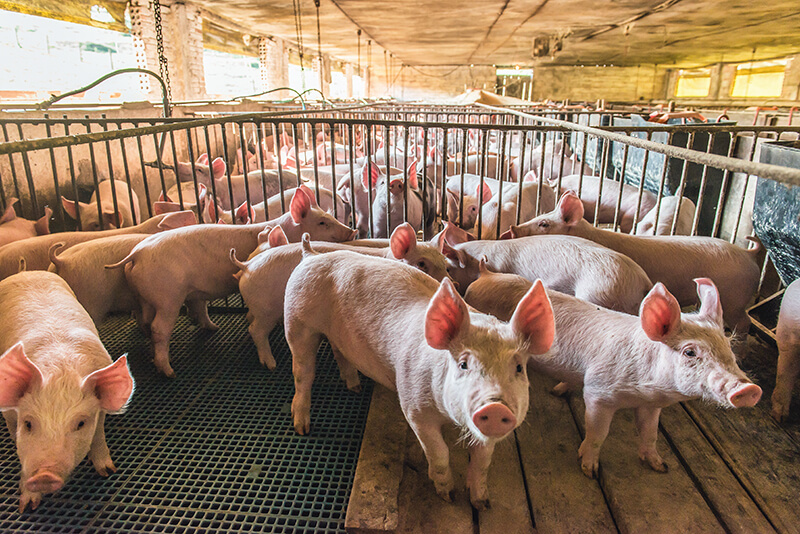Pigs on the Farm (Grades K-2)
Students explore the basic needs of animals and create a model of a modern pig barn that will help farmers meet the needs of the animals.

Background
Lesson Activities
Recommended Companion Resources
Credits
Author
Ohio Pork Council | Ohio Soybean Council and Ohio Pork Council in partnership with EducationProjects.org
Sources
- http://articles.extension.org/pages/68913/transport-and-care-of-pigs
- https://www.pork.org/cooking/pork-nutrition/vitamins-and-minerals/
- https://www.kfb.org/page/file?path=Files%2Fpage-161%2Fpig-tales%2FPorkFunFacts.pdf
- https://realpigfarming.com/15-trivia-winning-facts-about-pigs-6ab00f2d1049
Standards
Indiana Content Area Standards
-
English Language Arts.Kindergarten.SL.1
Listen actively and communicate effectively with a variety of audiences and for different purposes.
- Comprehension.K.SL.3.2: Ask appropriate questions about what a speaker says.
- Discussion and Collaboration.K.SL.2.1: Participate in collaborative conversations about grade-appropriate topics and texts with peers and adults in small and larger groups.
- Discussion and Collaboration.K.SL.2.3: Listen to others, take turns speaking, and add ones own ideas to small group discussions or tasks.
- Discussion and Collaboration.K.SL.2.4: Ask questions to seek help, get information, or clarify something that is not understood.
- Presentation of Knowledge and Ideas.K.SL.4.3: Give, restate, and follow simple two-step directions.
-
English Language Arts.Grade 1.SL.1
Listen actively and adjust the use of spoken language (e.g., vocabulary) to communicate effectively with a variety of audiences and for different purposes.
- Comprehension.1.SL.3.1: Ask and answer questions about what a speaker says to clarify something that is not understood.
- Discussion and Collaboration.1.SL.2.1: Participate in collaborative conversations about grade-appropriate topics and texts with peers and adults in small and larger groups.
- Discussion and Collaboration.1.SL.2.3: Listen to others, take turns speaking about the topic, and add ones own ideas in small group discussions or tasks.
- Discussion and Collaboration.1.SL.2.5: Build on others talk in conversations by responding to the comments of others through multiple exchanges.
- Presentation of Knowledge and Ideas.1.SL.4.2: Add drawings or other visual displays, such as pictures and objects, when sharing information to clarify ideas, thoughts, and feelings.
- Presentation of Knowledge and Ideas.1.SL.4.3: Give and follow three- and four-step directions.
-
English Language Arts.Grade 2.W.1
Write routinely over brief time frames and for a variety of tasks, purposes, and audiences; apply reading standards to write in response to literature and nonfiction texts.
- Handwriting.2.W.2.1: Write legibly by forming letters correctly and spacing words and sentences properly.
- Writing Genres.2.W.3.3: Develop topics for friendly letters, stories, poems, and other narrative purposes that a. Include a beginning. b. Use temporal words to signal event order (e.g., first of all). c. Provide details to describe actions, thoughts, and feelings. d. Provideanending.
-
English Language Arts.Grade 2.SL.1
Listen actively and adjust the use of spoken language (e.g., conventions, vocabulary) to communicate effectively with a variety of audiences and for different purposes.
- Comprehension.2.SL.3.2: Ask and answer questions about what a speaker says to clarify comprehension, gather information, or deepen understanding of a topic or issue.
- Discussion and Collaboration.2.SL.2.1: Participate in collaborative conversations about grade-appropriate topics and texts with peers and adults in small and larger groups.
- Discussion and Collaboration.2.SL.2.3: Listen to others, take ones turn in respectful ways, and speak one at a time about the topics and text under discussion.
- Discussion and Collaboration.2.SL.2.4: Ask for clarification and further explanation as needed about the topics and texts under discussion.
- Discussion and Collaboration.2.SL.2.5: Build on others talk in conversations by linking comments to the remarks of others.
- Presentation of Knowledge and Ideas.2.SL.4.2: Create simple presentations that maintain a clear focus, using various media when appropriate to clarify ideas, thoughts, and feelings.
- Presentation of Knowledge and Ideas.2.SL.4.3: Give and follow multi-step directions.